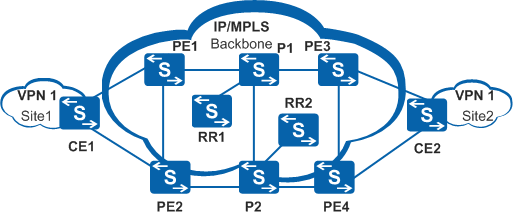BGP/MPLS IP VPN Application
Service Overview
BGP/MPLS IP VPN technology is deployed to meet service requirements. VPN labels distributed using MP-BGP enable packets to enter the correct VPN site and MPLS enables packets to be transparently transmitted over tunnels on the carrier's backbone network.
Figure 1 shows a typical networking example of BGP/MPLS IP VPN.
In Figure 1, Site1 and Site2 represent two networks in different cities. The two networks may be networks for two branches of a company or networks for municipal governments of the two cities. During communication between Site1 and Site2 data security must be ensured. The two networks must be separated from other networks and packets exchanged between the two networks must be transparently transmitted over the carrier's backbone network. Deploying BGP/MPLS VPN technology helps to meet this requirement.
Networking Description
To enable communication between sites, PE and P devices on the carrier's backbone network must be used to transmit routes and packets between Site1 and Site2. A CE device can be dual-homed to PE devices to ensure high network availability. Carriers typically deploy route reflectors (RRs) on the backbone network to reflect VPNv4 and VPNv6 routes.
Feature Deployment
Configure static routes between CE devices and PE devices or configure RIP, OSPF, IS-IS, or BGP on CEs and PEs for them to exchange routing information.
Configure MP-BGP peer relationships between all PE devices and RR1 and between all PE devices and RR2. Configure all PE devices as the clients of RR1 and RR2 and configure RR1 and RR2 to back up each other. The helps ensure network reliability.
Configure MPLS and an IGP on PE and P devices and establish MPLS tunnels for traffic forwarding.
- Adjust IGP costs of links to:
Ensure that the two links between CE1 and CE2 work in active/standby mode. If one link fails, traffic is switched to the other link for transmission.
Adjust the costs of links between RRs and the backbone network. Ensure that RRs are only used for route reflection not for traffic forwarding.
Configure VPN FRR for services that have high requirements for real-time transmission to enhance network reliability.
